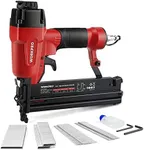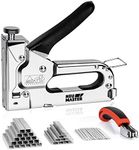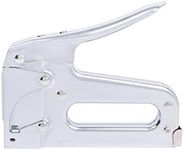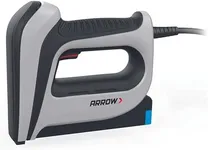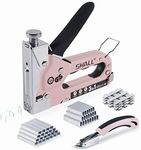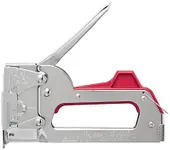Buying Guide for the Best Upholstery Staplers
Choosing the right upholstery stapler can make your furniture projects smoother, faster, and more enjoyable. Upholstery staplers are designed to attach fabric to furniture frames, and picking the right one depends on the type of work you plan to do, how often you’ll use it, and your comfort with different tools. Understanding the key features will help you select a stapler that matches your needs and ensures your projects look professional and last longer.Staple Type and SizeStaple type and size refer to the shape and length of the staples the stapler can use. This is important because different upholstery projects require different staple lengths and widths to hold fabric securely without damaging it. Staple sizes are usually measured in millimeters or inches, and the most common for upholstery are between 1/4 inch and 9/16 inch. Lighter projects like thin fabrics or delicate furniture may only need shorter, thinner staples, while heavier materials or thicker frames require longer, sturdier staples. When choosing, consider the thickness of the materials you’ll be working with and make sure the stapler supports the staple sizes you need.
Power SourceUpholstery staplers can be manual, electric, or pneumatic (air-powered). The power source affects how much effort you need to use and how quickly you can work. Manual staplers are hand-powered and best for small, occasional projects or when portability is important. Electric staplers plug in or use batteries, making them easier on your hands and faster for medium-sized jobs. Pneumatic staplers require an air compressor and are the most powerful, ideal for frequent, heavy-duty use. Think about how often you’ll use the stapler and the size of your projects to decide which power source fits your needs.
Ergonomics and WeightErgonomics and weight refer to how comfortable and easy the stapler is to hold and use, especially for long periods. A stapler that is too heavy or awkward can cause hand fatigue and make your work less precise. Lightweight models are easier to handle for detailed or overhead work, while heavier models may offer more stability for big projects. Look for a stapler with a comfortable grip and balanced weight, especially if you plan to use it for extended periods or have limited hand strength.
Magazine CapacityMagazine capacity is the number of staples the stapler can hold at once. A larger capacity means you can work longer without stopping to reload, which is helpful for big projects. Smaller capacities are fine for occasional or small jobs but may slow you down if you have a lot of stapling to do. Consider how much stapling you expect to do at one time and choose a capacity that matches your workflow.
Adjustable Power/Depth ControlSome upholstery staplers offer adjustable power or depth control, allowing you to set how deeply the staple is driven into the material. This is important for working with different fabric thicknesses and frame materials, as too much force can damage delicate fabrics, while too little may not hold the fabric securely. If you plan to work with a variety of materials, look for a stapler with this feature so you can adjust it to suit each project.
Safety FeaturesSafety features like trigger locks or nose safety mechanisms help prevent accidental firing, which is important for protecting your hands and work area. If you’re new to using staplers or will be working in a busy environment, choosing a model with good safety features can give you peace of mind and help prevent injuries.
